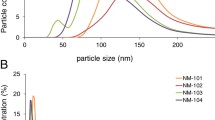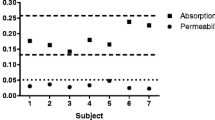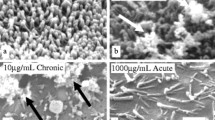Abstract
Certain food additives may contain a sizeable fraction of particles in the nanoscale. However, little is known about the fate, behaviour and toxicological effects of orally-ingested nanoparticles. This study investigated the uptake and biodistribution of nano- and larger-sized titanium dioxide (TiO2) using an in vitro model of gut epithelium and in vivo in rat. The results of the in vivo study showed that oral administration of 5 mg/kg body weight of TiO2 nano- or larger particles did not lead to any significant translocation of TiO2 (measured as titanium) either to blood, urine or to various organs in rat at any of the time intervals studied over a 96 h post-administration period. Different methods used for dispersing particles did not affect the uptake, and orally administered TiO2 was found excreted in the faeces over a period of time. The in vitro study provided further evidence for the lack of translocation of TiO2 across the gut epithelium model. The overall evidence from both in vivo and in vitro studies did not support that oral ingestion of nano- or larger particles of TiO2 via food would result in any significant internal exposure of the consumer to the nanoparticles. The dietary TiO2 nanoparticles are likely to be excreted in the faeces.







Similar content being viewed by others
References
Bohmert L, Girod M, Hansen U, Maul R, Knappe P, Niemann B, Weidner SM, Thunemann AF, Lampen A (2014) Analytically monitored digestion of silver nanoparticles and their toxicity on human intestinal cells. Nanotoxicology 8:631–642
Bouwmeester H, Poortman J, Peters RJ, Wijma E, Kramer E, Makama S, Puspitaninganindita K, Marvin HJ, Peijnenburg AA, Hendriksen PJ (2011) Characterization of translocation of silver nanoparticles and effects on whole-genome gene expression using an in vitro intestinal epithelium co-culture model. ACS Nano 5(5):4091–4103
Chaudhry Q, Castle L (2011) Food applications of nanotechnologies—an overview of opportunities and challenges for developing countries. Trends Food Sci Technol 22(2011):595–603
Chaudhry Q, Scotter M, Blackburn J, Ross B, Boxall A, Castle L, Aitken R, Watkins R (2008) Applications and implications of nanotechnologies for the food sector. Food Addit Contam 25(3):241–258
Chaudhry Q, Castle L, Watkins R (eds) (2010) Nanotechnologies in food. Royal Society of Chemistry Publishers, London. ISBN 978-0-85404-169-5
Chen M, von Mikecz A (2005) Formation of nucleoplasmic protein aggregates impairs nuclear function in response to SiO2 nanoparticles. Exp Cell Res 305(1):51–62
Commission Directive 2006/33/EC of 20 March 2006 amending Directive 95/45/EC as regards sunset yellow FCF (E 110) and titanium dioxide (E 171)
Deli MA (2009) Potential use of tight junction modulators to reversibly open membranous barriers and improve drug delivery. Biochim Biophys Acta 1788(4):892–910
des Rieux A, Fievez V, Garinot M, Schneider YJ, Preat V (2006) Nanoparticles as potential oral delivery systems of proteins and vaccines: a mechanistic approach. J Control Release 116:1–27
des Rieux A, Fievez V, Théate I, Mast J, Préat V, Schneider Y-J (2007) An improved in vitro model of human intestinal follicle-associated epithelium to study nanoparticle transport by M cells. Eur J Pharm Sci 30(5):380–391
Desai MP, Labhasetwar V, Amidon GL, Levy RJ (1996) Gastrointestinal uptake of biodegradable microparticles: effect of particle size. Pharm Res 13(120):1838–1845
EFSA [European Food and Safety Authority] (2004) Opinion of the scientific panel on food additives, flavourings, processing aids and materials in contact with food on a request from the commission related to the safety in use of rutile titanium dioxide as an alternative to the presently permitted anatase form, Question No EFSA-Q-2004-103, Adopted on 7 December 2004. EFSA J 163:1–12
Frewer L, Norde N, Fischer A, Kampers F (eds) (2011) Nanotechnology in the agri-food sector. Implications for the future. Wiley, Weinheim. ISBN: 978-3-527-33060-7.
Geiser M, Kreyling WG (2010) Deposition and biokinetics of inhaled nanoparticles. Part Fibre Toxicol 20(7):2
Gerloff K, Pereira DI, Faria N, Boots AW, Kolling J, Forster I, Albrecht C, Powell JJ, Schins RP (2013) Influence of simulated gastrointestinal conditions on particle-induced cytotoxicity and interleukin-8 regulation in differentiated and undifferentiated Caco-2 cells. Nanotoxicology 7:353–366
Gui S, Sang X, Zheng L, Ze Y, Zhao X, Sheng L, Sun Q, Cheng Z, Cheng J, Hu R, Wang L, Hong F, Tang M (2013) Intragastric exposure to titanium dioxide nanoparticles induced nephrotoxicity in mice, assessed by physiological and gene expression modifications. Part Fibre Toxicol 10:4. doi:10.1186/1743-8977-10-4
Hillyer JF, Albrecht RM (2001) Gastrointestinal persorption and tissue distribution of differently sized colloidal gold nanoparticles. J Pharm Sci 90:1927–1936
Hoet P, Bruske-Hohlfeld I, Salata O (2004) Nanoparticles—known and unknown health risks. J Nanobiotechnol 2:1–15
Jani P, Halbert GW, Langridge J, Florence AT (1990) Nanoparticle uptake by the rat gastrointestinal mucosa: quantitation and particle size dependency. J Pharm Pharmacol 42(12):821–826
Jani P, McCarthy D, Florence AT (1994) Titanium dioxide (rutile) particle uptake from the rat GI tract and translocation to systemic organs after oral administration. Int J Pharmacol 105(2):157–168
Kim YS, Kim JS, Cho HS, Rha, DS, Kim JM, Park JD, Choi BS, Lim R, Chang HK, Chung YH, Kwon H, Jeong J, Han BS, Yu J (2008) Twenty-eight-day oral toxicity, genotoxicity, and gender-related tissue distribution of silver nanoparticles in Sprague-Dawley rats. Inhal Tox 20:575–583
Lai SK, O’Hanlon DE, Harrold S, Man ST, Wang Y-Y, Cone R, Hanes J (2007) Rapid transport of large polymeric nanoparticles in fresh undiluted human mucus. PNAS 104:1482–1487
McKenzie J, Charlton A, Donarski J, MacNicoll A, Wilson J (2010) Peak fitting in 2D 1 H–13 C HSQC NMR spectra for metabolomic studies. Metabolomics 6(4):574–582
Ohno T, Sarukawa K, Matsumura M (2001) Photocatalytic activities of pure rutile particles isolated from TiO2 powder by dissolving the anatase component in HF solution. J Phys Chem B 105(12):2417–2420
Peters RJB, van Bemmel G, Herrera-Rivera Z, Helsper HPFG, Marvin HJP, Weigel S, Tromp PC, Oomen AG, Rietveld AG, Bouwmeester H (2014) Characterization of titanium dioxide nanoparticles in food products: analytical methods to define nanoparticles. J Agric Food Chem 62:6285–6293
Powell JJ, Faria N, Thomas-McKay E, Pele LC (2010) Origin and fate of dietary nanoparticles and microparticles in the gastrointestinal tract. J Autoimmun 34(3):J226–J233
Šimon P, Joner E (2008) Conceivable interactions of biopersistent nanoparticles with food matrix and living systems following from their physicochemical properties. J Food Nutr Res 47:51–59
Tassinari R, Cubadda F, Moracci G, Aureli F, D’Amato M, Valeri M, De Berardis B, Raggi A, Mantovani A, Passeri D, Rossi M, Maranghi F (2013) Oral, short-term exposure to titanium dioxide nanoparticles in Sprague-Dawley rat: focus on reproductive and endocrine systems and spleen. Nanotoxicology. doi:10.3109/17435390.2013.822114 Early online posted on July 25, 2013
Tomita M, Hayashi M, Awazu S (1996) Absorption-enhancing mechanism of EDTA, caprate, and decanoylcarnitine in Caco-2 cells. J Pharm Sci 85(6):608–611
Wang J, Zhou G, Chen C, Yu H, Wang T, Ma Y, Jia G, Gao Y, Li B, Sun J, Li Y, Jiao F, Zhao Y, Chai Z (2007) Acute toxicity and biodistribution of different sized titanium dioxide particles in mice after oral administration. Toxicol Lett 168(2):176–185
Weir A, Westerhoff P, Fabricius L, Hristovski K, von Goetz N (2012) Titanium dioxide nanoparticles in food and personal care products. Environ Sci Technol 46(4):2242–2250
Acknowledgments
The authors gratefully acknowledge funding for this research from the Food Standards Agency. Acknowledgments are also due to Roy McArthur for statistical analysis and Malcolm Baxter and Michael Walls for analysis of samples using ICP-MS.
Author information
Authors and Affiliations
Corresponding author
Rights and permissions
About this article
Cite this article
MacNicoll, A., Kelly, M., Aksoy, H. et al. A study of the uptake and biodistribution of nano-titanium dioxide using in vitro and in vivo models of oral intake. J Nanopart Res 17, 66 (2015). https://doi.org/10.1007/s11051-015-2862-3
Received:
Accepted:
Published:
DOI: https://doi.org/10.1007/s11051-015-2862-3




